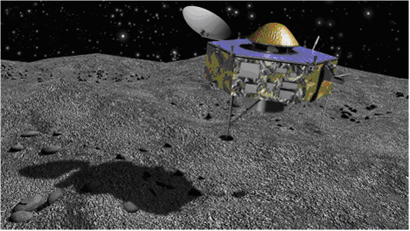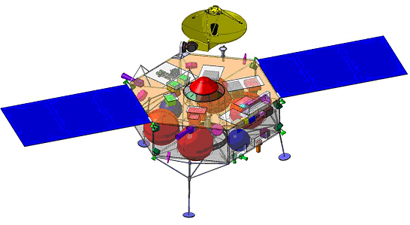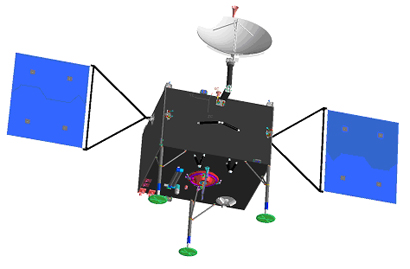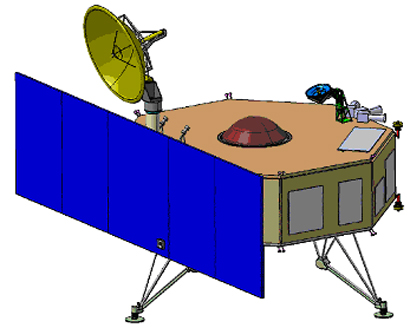Marco Polo Mission Summary
[Note: This summary describes a mission called Marco Polo that was studied by ESA and industry between 2007 and 2010. Another mission named MarcoPolo-R was proposed to ESA in response to a call in 2010; this was selected in February 2011 for further study – see also "Candidates selected for ESA's next medium-class mission" in the right-hand menu.]
Marco Polo was proposed by the scientific community in response to a call from ESA, in 2007, for new missions for the Cosmic Vision 2015-2025 programme. By returning a pristine sample of a near-Earth asteroid to Earth, Marco Polo would address one of the core themes of Cosmic Vision: How does the Solar System work?
 |
|
Conceptual design of the Marco Polo spacecraft descending towards the sampling site. Credit: ESA |
As one of six M-class candidate missions selected for further consideration after this first call, Marco Polo was subject to assessment studies by ESA and by three independent industrial consortia (Astrium (UK), OHB (Germany) and Thales (Italy)). In early 2010 the advisory body structure of ESA's Science and Robotic Exploration Directorate met to consider the outcome of these studies. Marco Polo was not selected to continue to the next phase.
The main aim of the mission was to return a sample of a near-Earth asteroid (NEA) to Earth for laboratory analysis – the candidate NEA chosen for the study was 1999 JU3. As some of the oldest objects in the Solar System, asteroids provide a glimpse at both the infancy and the evolution of our place in space. The terrestrial planets are thought to have formed from the coalescence of asteroid-like objects and a sample return would provide a unique insight into planetary formation. It has also been suggested that asteroids helped supply the primitive Earth with the organic compounds necessary for life; a sample return from 1999 JU3 could aid understanding in this area.
Two separate sampling techniques were offered up for consideration. The first would have seen Marco Polo descend to the asteroid's surface and spend 10-20 minutes drilling for a sample. The second option was a much swifter "touch and go" method with the spacecraft only in contact with 1999 JU3 for 3 seconds. In the latter case a device would extend from the landing feet to ensnare the sample. There was a provision for up to two retries should initial attempts fail.
Both strategies would have collected dust and centimetre-sized samples from the asteroid, which would then be transferred to an Earth re-entry capsule, complete with the sampling mechanism, and sealed. Upon return to Earth the re-entry capsule, weighing between 30 and 70 kg depending on the design and coated in a heat shield, would detach from the mother spacecraft. It would then descend through the Earth's atmosphere before deploying a parachute and floating to the ground for collection in Woomera, Australia.
The mother spacecraft, weighing around 1400 kg, was also set to carry a suite of instrumentation to study 1999 JU3, including scientific cameras, a pair of infrared spectrometers to analyse its chemical composition and thermo-physical properties, and a radio science experiment to determine its mass and structure.
The proposed mission timeline had Marco Polo launched on a Soyuz-Fregat rocket from French Guiana in December 2018. After getting a gravitational boost from swinging past the Earth twice - in December 2019 and again one year later – Marco Polo would then have arrived at 1999 JU3 in February 2022. Before landing on the asteroid the spacecraft would have spent 6-7 months both making in-situ scientific measurements and looking for the best place to land. After collecting its sample, Marco Polo would have then headed back for Earth in July 2023, arriving in December 2024.
Marco Polo was proposed as a collaboration with the Japan Aerospace Exploration Agency (JAXA) and was named after one of the first western people to build good relations between Europe and Asia.
|
Spacecraft design concepts for Marco Polo |
 |
|
Above: EADS Astrium design concept for Marco Polo |
 |
|
Above: OHB-System AG design concept for Marco Polo |
 |
|
Above: Thales Alenia Space design concept for Marco Polo |
Further details about the Marco Polo mission can be found in the links in the right-hand menu.
